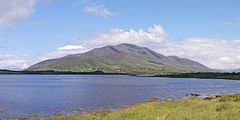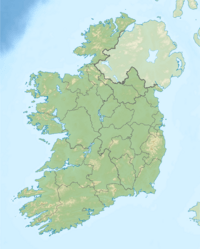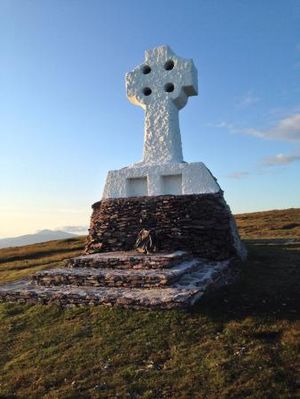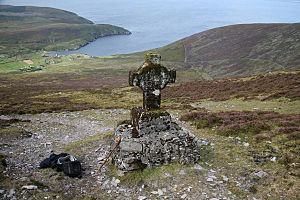Knocknadobar facts for kids
Quick facts for kids Knocknadobar |
|
|---|---|
| Cnoc na dTobar | |
 |
|
| Highest point | |
| Elevation | 690 m (2,260 ft) |
| Prominence | 565 m (1,854 ft) |
| Listing | Marilyn, Hewitt, Arderin, Simm, Vandeleur-Lynam |
| Naming | |
| English translation | hill of the wells |
| Language of name | Irish |
| Geography | |
| Parent range | Mountains of the Iveragh Peninsula |
| OSI/OSNI grid | V506845 |
| Geology | |
| Mountain type | Purple sandstone & siltstone |
Knocknadobar (which means Cnoc na dTobar, or "hill of the Wells" in Irish) is a mountain in County Kerry, Ireland. It stands at 690 meters (about 2,264 feet) tall. This makes it one of the highest peaks in Ireland. Knocknadobar is a major mountain in the Iveragh Peninsula. For a very long time, since the Middle Ages, it has been an important place for pilgrimages. A pilgrimage is a special journey to a holy place.
What's in a Name?
The name Knocknadobar means "hill of the wells." This name makes a lot of sense for this mountain. It is located in the southwest corner of Ireland. This area gets a lot of rain from the Atlantic Ocean. Because of all this rain, fresh water often springs right out of the ground. These natural springs are like wells.
There are also holy wells at the base of the mountain. One of the most famous is St. Fursey's Holy Well. People have visited this well for pilgrimages since medieval times. It is named after Saint Fursey, who lived a very long time ago (around 597–650 AD). People believed that St. Fursey's Holy Well could help with eye problems.
Where is Knocknadobar?
Knocknadobar is located northeast of a town called Cahersiveen. It is also north of the N70 road, right on the coast of Dingle Bay. This mountain stands almost by itself. This means it rises very clearly from the land around it.
Even though it is 690 meters tall, it has a "prominence" of 565 meters. Prominence measures how much a mountain rises above the lowest point connecting it to a higher peak. Because of its prominence, Knocknadobar is recognized as an important mountain in the British Isles. It is listed on several mountain classifications, like the Marilyn and Hewitt lists. It is also one of the top 100 highest mountains in Ireland.
A Place of Pilgrimage
Cnoc na dTobar has been a special pilgrim mountain for a very long time. Even before Christianity came to Ireland, people celebrated here. In the 5th century, ancient Celtic people held Lúghnasa Festivals on the mountain in August. Lúgh (pronounced "Loo") was the god of the harvest. People would dance and celebrate on high ground to ask for a good harvest. Knocknadobar's wide, flat top was a perfect place for these festivals. The Irish word for August, "Lúhgnasa," comes from these ancient celebrations.
Later, in 1884–85, Christian crosses were placed along the old pilgrim trail. These crosses represent the 14 stations of the cross. An altar and a large Celtic cross were also placed at the very top of the mountain. A special mass is held there every year. These works were done by Canon Brosnan from Cahersiveen.
The full Cnock na dTobar Pilgrimage Path is about 9 kilometers long. It takes about 3.5 hours to walk the whole route. This path is part of the National Pilgrim Passport scheme, which is run by Pilgrim Paths of Ireland. From the flat top of Knocknadobar, you can see amazing views of other important pilgrimage sites. These include Mount Brandon and Skellig Michael.




